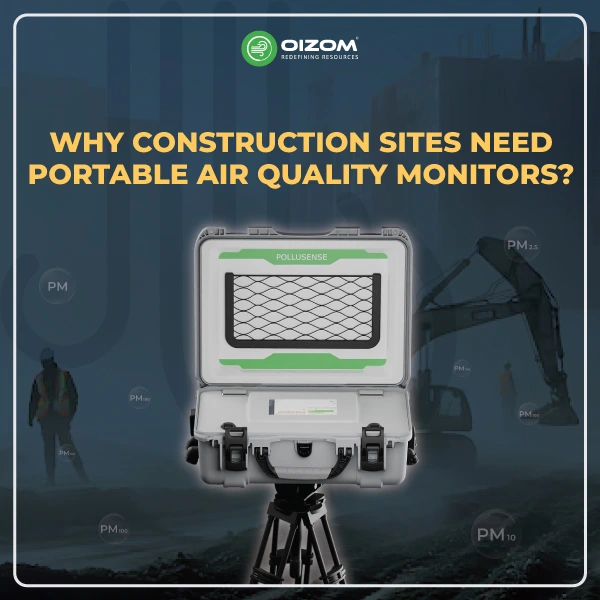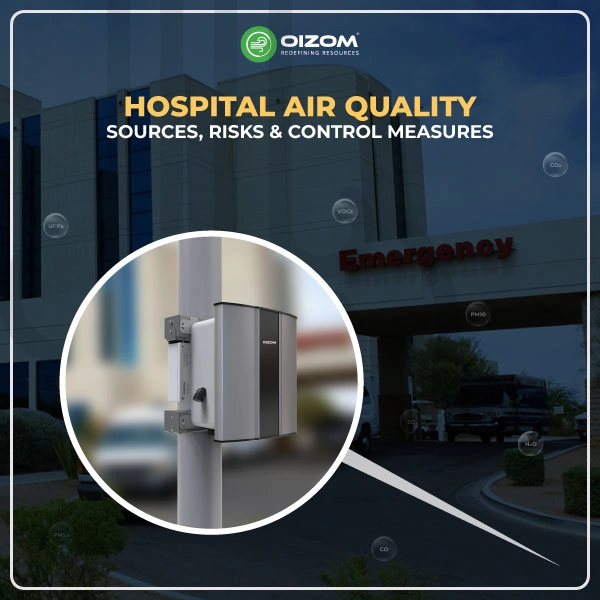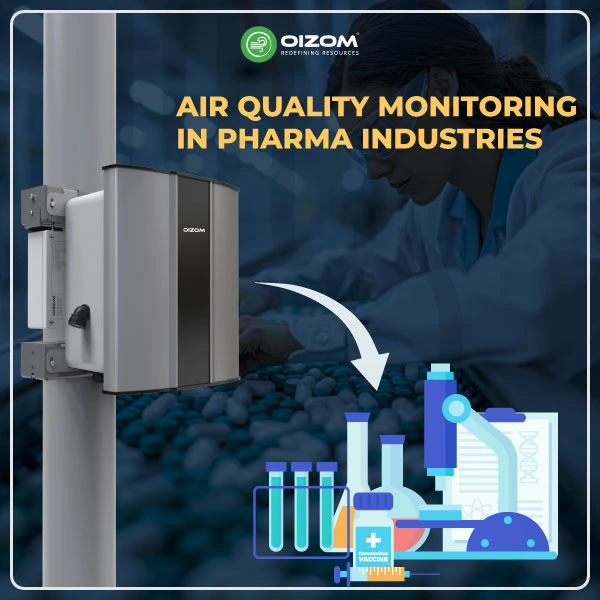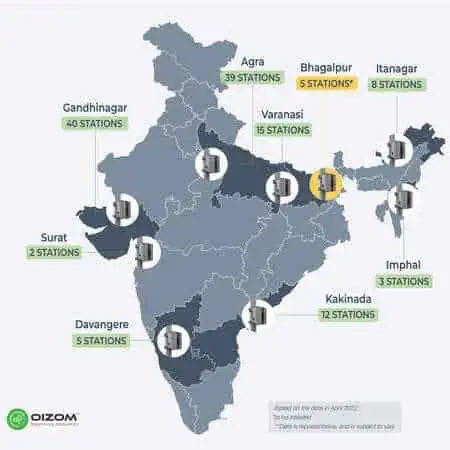10 key takeaway points:
- Construction’s Environmental Impact: Construction sites produce dust, VOCs, and noise, affecting both human health and the environment.
- High Material Use: The construction industry uses over 400 million tons of materials annually, contributing to pollution.
- Importance of Monitoring: Establishing a high-resolution air quality monitoring network helps quantify and manage pollution levels on-site and in surrounding areas.
- Pollusense Advantage: Oizom’s Pollusense is a portable air quality monitor providing accurate, real-time data on various pollutants, including particulate matter and gases.
- Health Protection: Real-time monitoring protects worker health by detecting harmful pollution spikes, allowing immediate action.
- Environmental Compliance: Monitoring helps ensure compliance with health and environmental regulations, avoiding fines and project delays.
- Enhanced Decision-Making: Accurate data allows site managers to make informed decisions on mitigating pollution impacts.
- Network Agnostic: Pollusense supports multiple connectivity options (LoRa, GSM, LTE, WiFi, Satellite), ensuring reliable data transmission anywhere.
- Long-Term Investment: Portable air quality monitors offer a strong ROI by enhancing safety, efficiency, and sustainability on construction sites.
- Commitment to Sustainability: Portable air quality monitoring encourages sustainable construction practices, reducing pollution’s negative impact.
Why Construction Sites Need Portable Air Quality Monitors?
We all know construction can be a real headache; listening to drills and hammers in the early morning isn’t exactly a pleasant wake-up call. But beyond being a nuisance, all that noise actually impacts wildlife, too. And it’s not just the sound; construction zones are major sources of air pollution, releasing particulate matter and volatile organic compounds that harm people and the environment. Surprising, right?
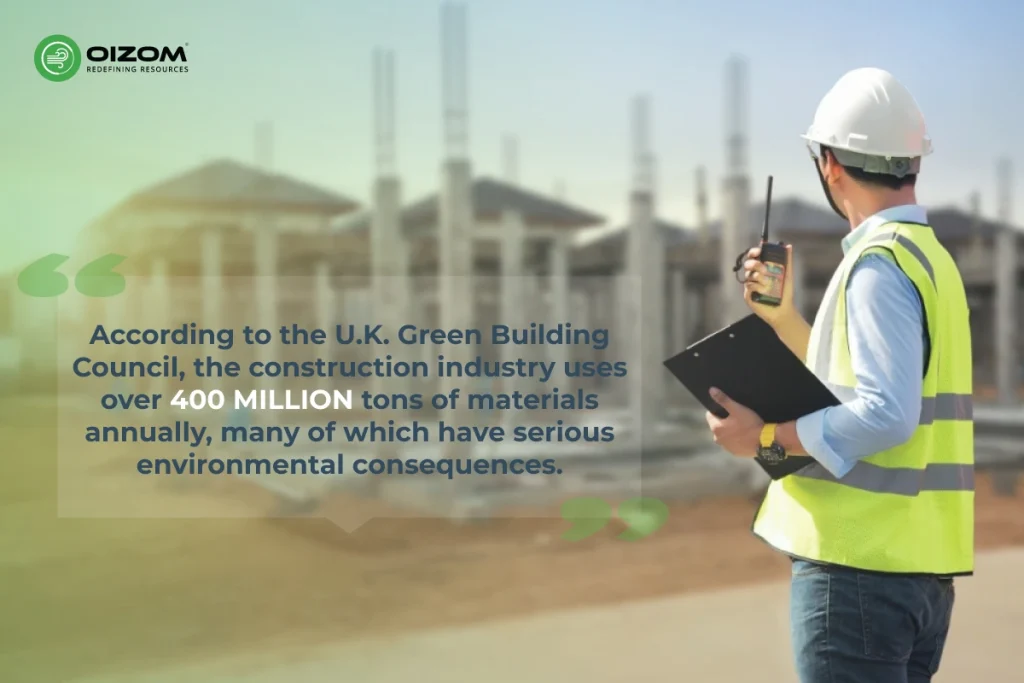
Pollusense empowers construction teams to monitor air quality dynamically, helping protect workers, communities, and the environment.While building activities can generate considerable levels of air pollution, there are certain techniques to mitigate these effects. One important strategy for mitigating the effects of a building project is to establish a high-resolution air quality monitoring network. You can’t manage what you can’t measure, so it is essential to understand the pollution levels affecting the site and surrounding communities. That’s where Oizom’s latest innovation launched on November 7th, 2024. Pollusense. This portable air quality monitor is a game-changer for construction sites, delivering accurate, real-time data on pollutants wherever it’s needed.
Why Air Quality Monitoring is Crucial for Construction Sites
The construction sector has a major negative impact on air quality. According to a UK-based source, the construction industry has increased its overall contribution of emissions in recent decades, while other sectors, such as transportation, have reduced their share through laws such as ultra-low emission zones. This could be due to the building industry receiving less attention for its polluting effects, combined with a tendency to have less stringent air quality rules.
Dust generated during construction and demolition activities, such as excavation, loading and unloading, raw material preparation, and road building, is a major source of construction-related pollution. Construction and demolition activities have a substantial impact on air quality, emitting dangerous chemicals that endanger workers and the surrounding community. To address this matter, installing adequate air quality monitoring systems in construction zones is critical. Construction businesses can improve sustainability by correctly monitoring emissions, detecting air contaminants, and adopting control measures.
This dust contains particle debris and volatile organic compounds, which can be carried around the building site and neighboring neighborhoods by wind. Mold, asbestos, lead, bird excrement, and other respiratory irritants can be released during demolition, endangering construction workers and adjacent inhabitants.
Understanding the Role of Portable Air Quality Monitors in Construction Sites
Construction dust is an often overlooked but serious threat on bustling construction sites. While towering cranes and noisy machinery grab attention, the fine dust particles like silica, wood dust, and cement silently remain in the air. These tiny particles, often less than 10 micrometers, can easily enter the respiratory system, posing serious health risks. This dust isn’t just a byproduct; it’s a real environmental and health hazard. Understanding its impact is crucial to keeping workers and nearby communities safe.
With portable monitors, site managers can track air quality on the go, quickly monitoring pollution spikes and adjusting activities to minimize impact. That’s where Pollusense comes in. As a portable air quality monitor, Pollusense is designed to track particulate matter like construction dust in real-time. With its compact, rugged design, it’s easy to move around different sites, and its accurate monitoring helps you take immediate action to minimize dust exposure. Whether it’s measuring dust levels or tracking harmful gases, Pollusense equips you with the data you need to ensure a safer and healthier construction environment.
Why Air Quality Monitoring is Crucial for Construction Sites
The construction sector has a major negative impact on air quality. According to a UK-based source, the construction industry has increased its overall contribution of emissions in recent decades, while other sectors, such as transportation, have reduced their share through laws such as ultra-low emission zones. This could be due to the building industry receiving less attention for its polluting effects, combined with a tendency to have less stringent air quality rules.
Dust generated during construction and demolition activities, such as excavation, loading and unloading, raw material preparation, and road building, is a major source of construction-related pollution. Construction and demolition activities have a substantial impact on air quality, emitting dangerous chemicals that endanger workers and the surrounding community. To address this matter, installing adequate air quality monitoring systems in construction zones is critical. Construction businesses can improve sustainability by correctly monitoring emissions, detecting air contaminants, and adopting control measures.
This dust contains particle debris and volatile organic compounds, which can be carried around the building site and neighboring neighborhoods by wind. Mold, asbestos, lead, bird excrement, and other respiratory irritants can be released during demolition, endangering construction workers and adjacent inhabitants.
Understanding the Role of Portable Air Quality Monitors in Construction Sites

Construction dust is an often overlooked but serious threat on bustling construction sites. While towering cranes and noisy machinery grab attention, the fine dust particles like silica, wood dust, and cement silently remain in the air. These tiny particles, often less than 10 micrometers, can easily enter the respiratory system, posing serious health risks. This dust isn’t just a byproduct; it’s a real environmental and health hazard. Understanding its impact is crucial to keeping workers and nearby communities safe.
With portable monitors, site managers can track air quality on the go, quickly monitoring pollution spikes and adjusting activities to minimize impact. That’s where Pollusense comes in. As a portable air quality monitor, Pollusense is designed to track particulate matter like construction dust in real-time. With its compact, rugged design, it’s easy to move around different sites, and its accurate monitoring helps you take immediate action to minimize dust exposure. Whether it’s measuring dust levels or tracking harmful gases, Pollusense equips you with the data you need to ensure a safer and healthier construction environment.
Protecting Worker Health and Safety
- You can take various steps, beginning with constantly considering the possibility that the construction you are working on may contain dust and volatile organic compounds.
- Construction site managers must do a risk assessment before undertaking any maintenance, remodeling, demolition, or other construction activity to detect the presence of dust, mold, asbestos, and lead.
- Protecting worker health and safety is essential on every worksite, especially in industries like construction. Daily exposure to dust, fumes, and noise can have serious health impacts over time.
Reducing Environmental Impact
One of the most serious environmental challenges with concrete construction sites is the high carbon emissions produced. The following sustainable methods can be implemented to reduce emissions and further reduce the environmental consequences of concrete construction sites.
- Sustainable site planning and design
- Utilizing sustainable building materials
- Construction waste reduction and recycling
- Green building certifications and regulations
Ensuring Regulatory Compliance
Environmental regulations in the construction sector aim to reduce the environmental impact of construction activities. These standards cover a wide range of construction issues, including waste management, air quality control, water conservation, and the use of sustainable materials.
Not only is construction dust control necessary for the safety and well-being of employees and the general public, but it is also critical to conduct workplace construction dust monitoring to verify that local and national authority legislation and air quality requirements are followed. Employers are legally required to prevent or appropriately control worker exposure to construction dust.
The Indian government realized the problem and developed a technique to reduce dust. The Ministry of Environment, Forest, and Climate Change has issued a notice regarding construction pollution at project sites across India that fall under the Commission for Air Quality and Management (CAQM). A bunch of instructions from the government of India are given to curb the construction and demolition activities in India.
Working Mechanism of Portable Air Quality Monitors on Construction Sites
Portable air quality monitoring functions are pretty cool. They detect and measure pollutants in the air around you. They’re packed with sensors that track specific things like particulate matter (PM), gases like CO2, NO2, ozone, and even environmental factors like temperature, humidity, and pressure. These sensors gather data in real-time, giving you an immediate snapshot of the air quality at any moment.
These devices typically use laser-based or electrochemical sensors, NDIR, and PID to measure pollutant levels. For example, laser sensors detect particulate matter by measuring how light scatters when it hits particles in the air. Electrochemical sensors measure gases by reacting chemically with pollutants, producing an electrical signal.
What really makes portable monitors stand out is their mobility. Unlike fixed monitors, you can use them anywhere from industrial sites to neighborhoods, providing flexible and immediate air quality assessments. Many also feature wireless connectivity to send real-time data straight to your smartphone or cloud platforms for easy analysis.
Key Parameters Monitored on Construction Sites
Construction or demolition work degrades air quality in three major ways. On construction sites, key parameters for air quality monitoring include:
- Dust is a nuisance. The circulation of machinery, demolition operations, and material loading and unloading all emit suspended particles (PM10, PM2.5, and PM1) that can pose health concerns when inhaled, particularly among the most vulnerable populations.
- Machinery produces atmospheric emissions. Construction machinery produces noise, dust, and gasses like NOx and CO.
- Transportation of construction supplies. The processing of construction materials adds to increasing pollution levels, particularly particulate matter.
Particulate Matter (PM)
So, what characteristics do particle matter have? According to the USEPA, particulate matter (PM) is a mixture of solid particles and liquid droplets in the air. Some particles, such as dust and dirt, are visible to the human eye, while others are so minute that they can only be seen with a microscope. They are collectively responsible for all the particle pollution we see daily.
The consequences of particulate matter on human health vary with particle diameter, so monitoring different particle sizes, such as PM2.5 and PM10, is crucial. There is a famous saying that “You cannot manage what you cannot measure.”. Whether you’re managing construction sites, mines, or ports, using a Portable Particulate Monitor ensures accurate air quality tracking, from the tiniest PM1 particles to the largest PM100.
Did you know this? Only 9% of countries have ambient air quality standards for particulate matter pollution (PM2.5) that meet World Health Organization (WHO) guidelines.
Volatile Organic Compounds (VOCs)
Volatile organic compounds (VOCs) include butane, toluene, pentane, propane, xylene, and ethanol. Volatile organic compounds can originate from a variety of sources, including:
- Cars and gasoline-fueled engines
- Consumer goods such as paint, pesticides, and cleansers
- Industrial solvents and chemical manufacture.
VOCs can act as greenhouse gases, causing atmospheric warming. However, like CO, they largely contribute to climate change by participating in the chemical process that generates ground-level ozone. In the presence of sunshine, VOCs combine with nitrous oxides and carbon monoxide to form ozone.
Carbon Monoxide (CO)
Carbon monoxide (CO) is an odorless, colorless, and tasteless gas that cannot be detected by the human senses. Carbon monoxide poisoning is sometimes referred to as a “silent killer” due to its indistinguishable. Carbon monoxide can be hazardous if inhaled.As it enters the bloodstream, it can hinder your body from taking oxygen properly, causing tissue damage and, eventually, death.
According to the CDC, more than 20,000 patients visit the emergency room each year as a result of carbon monoxide poisoning. While no one is immune to the effects of this deadly gas, newborns, the elderly, and persons with heart or respiratory issues are more vulnerable to CO poisoning.
Nitrogen Dioxide (NO2)
Nitrogen dioxide, or NO2, is a gaseous air pollutant made up of nitrogen and oxygen. It is part of a group of gases known as nitrogen oxides, or NOx. Nitrogen dioxide is produced when fossil fuels like coal, oil, methane gas (natural gas), or diesel are burned at high temperatures. In outdoor air, NO2 and other nitrogen oxides contribute to particle pollution and the chemical processes that produce ozone.
It is a respiratory irritant that can exacerbate the symptoms of an existing respiratory infection. Nitrogen dioxide increases the susceptibility of asthmatics to lung infections and asthma triggers such as pollen and exercise.
Data Collection and Transmission
Oizom Pollusense is designed to provide users with a seamless, reliable air quality monitoring experience, no matter the environment. Pollusense delivers accurate data continuously at construction sites, undeterred by harsh conditions.
Paired with Oizom’s Envizom, an advanced air quality visualization and analytics platform, users can access real-time data and insights. Powered by AI and Machine Learning, Envizom ensures precise data interpretation, enabling users to make informed decisions quickly and effectively.
Benefits of Using Portable Air Quality Monitors on Construction Sites
Using portable air quality monitors on construction sites offers a range of benefits for both workers and the surrounding community. These devices provide real-time insights into air quality, allowing site managers to detect spikes in pollutants like dust, volatile organic compounds (VOCs), and gases such as CO2 and NO2. By catching these changes early, they can adjust work activities or implement controls to reduce harmful exposure, protecting worker health and safety.
Unlike fixed monitors, portable devices can be easily moved to different areas of the site, offering flexible monitoring as construction progresses. This adaptability ensures a more accurate picture of air quality across the entire site, helping maintain compliance with environmental standards and building community trust.
Early Detection of Pollutants and Hazards
Early detection of pollutants and hazards is crucial on construction sites to keep workers safe and the environment protected. By identifying pollutants like dust, volatile organic compounds (VOCs), and harmful gases (such as CO2 and NO2) early on, site managers can act swiftly to control exposure, reducing health risks for everyone on-site. Portable air quality monitors make this possible by providing real-time data on pollutant levels. This data helps teams adjust activities and implement safety measures proactively. Early detection not only safeguards worker health but also ensures compliance with environmental standards, creating a safer, cleaner construction environment.
Better Compliance with Health and Safety Regulations
Because of construction’s major detrimental influence on air quality, several governments and organizations around the world have implemented regulatory frameworks to regulate pollutant exposure.
Recognizing the effects of air pollution on construction workers, whether caused by pollution produced on the job site or by other sources to which they are exposed, such as wildfires, and implementing regulations is critical in protecting those working on the job site who are most vulnerable to harmful exposure.
Better compliance with health and safety regulations is essential on construction sites, where air quality and noise levels can directly impact worker well-being. Using portable air quality monitors, site managers can easily track pollutants like dust and harmful gases in real-time, ensuring they stay within safe limits. Staying on top of these regulations also minimizes the risk of fines and legal issues, making portable monitors a smart, efficient tool for creating a compliant, safer construction environment.
Enhanced Decision Making and Site Management
Enhanced decision-making and site management are vital for efficient, safe construction. With accurate data, managers can better allocate resources, implement protective measures, and meet environmental standards.
Sustainable site planning or management is designing a construction project while considering the environment. It considers site selection, landscaping, and stormwater management. Planning a site sustainably reduces the negative consequences of development on the surrounding area.
Choosing the Right Portable Air Quality Monitor for Your Construction Site
Choosing the right portable air quality monitoring system for your construction site keeps workers safe and complies with regulations. It’s essential to consider a few key questions. With so many options, knowing what to look for can make all the difference. First, consider the types of pollutants your site typically encounters, like particulate matter (PM), VOCs, or specific gases such as CO2 and NO2. A good monitor should be equipped to measure these accurately in real-time.
Next, think about the monitor’s mobility and ease of use. A truly portable monitor should be easy to move around, allowing you to track air quality across various areas on the site. Look for features like wireless connectivity and data storage capabilities for effortless data management. Consider durability and battery life to ensure it withstands tough site conditions. Finally, Reviewing costs is also crucial; lower-cost sensors can range from $150 to $10,000, depending on the pollutants measured.
Identifying Specific Site Requirements
Identifying specific site requirements is crucial in choosing the right air quality monitoring setup on construction sites. Each site has its own challenges based on location, project type, and activities. For example, heavy machinery releases particulate matter (PM) and diesel emissions, requiring specialized monitors, while sites near residential areas might focus more on noise and VOC levels to reduce community impact.
Start by listing potential pollutants and hazards specific to your site. Are dust, gases like CO2 and NO2, or noise a concern? This helps narrow down the monitoring tools you’ll need. Next, consider which air quality monitoring system you need: Portable or Stationary. Portable monitors are ideal for flexibility, as they can be moved across different site areas, capturing real-time data in dynamic environments. However, stationary air quality monitoring systems also play a significant role. These fixed systems offer continuous, high-resolution data from a single location, making them perfect for long-term projects where consistent air quality data is crucial.
Evaluating Cost and ROI
When it comes to air quality monitoring on construction sites, evaluating cost and ROI is essential to make an informed investment. While portable and stationary air quality monitors come with varying price tags, the benefits they offer can quickly outweigh initial costs. Think about it: these monitors help maintain compliance with health and environmental regulations, reducing the risk of hefty fines or project delays due to pollution concerns.
Additionally, air quality monitors protect worker health by identifying pollution spikes early on, which can lower health-related costs and boost productivity by keeping the team safe. For sites near residential areas, good air quality management also fosters community trust, potentially preventing costly disputes or complaints.
When evaluating ROI, consider both short-term savings and long-term benefits. A reliable air quality monitoring system isn’t just an expense. It’s an investment in safer, more efficient operations that can yield significant returns over time
Comparing Technical Specifications and Reviews
When choosing an air quality monitor for a construction site, comparing technical specifications and reviews is essential. Different monitors have different capabilities, so start by focusing on the specifications that matter most for your site, such as the ability to detect particulate matter (PM), gases, noise, or humidity. Some monitors may also offer advanced features like real-time data connectivity or rugged designs for harsh environments.
Case studies or reviews are a great way to see how these monitors perform in real-world settings. Look for feedback on aspects like ease of setup, accuracy, durability, and battery life. Reviews from users in similar industries or construction sites can provide valuable insights into how well a monitor holds up to the demands of daily use.
Did you know that? Oizom’s Pollusense stands out, especially for construction sites. This portable monitor can detect multiple pollutants, including particulate matter (PM), gases, noise, and even temperature and humidity. Its versatility makes it a valuable tool for real-time air quality management on dynamic construction sites.
One of Pollusense’s key strengths is its network-agnostic design, supporting a wide range of connectivity options, including LoRa, GSM, LTE, WiFi, and Satellite. This means it can seamlessly integrate into any network, whether you’re working in urban areas or remote construction sites, providing reliable data transmission regardless of location.
Conclusion
In conclusion, construction sites significantly impact air quality and climate, but with proactive steps, these effects can be minimized. Setting up portable air quality monitors, like Oizom’s Pollusense, is essential for understanding and managing site emissions in real-time. Pollusense captures accurate data on dust, VOCs, noise, and various pollutants, providing site managers with the insights they need to implement effective mitigation strategies. By prioritizing air quality monitoring and sustainable practices, we can reduce the negative impacts of construction-produced air pollution

